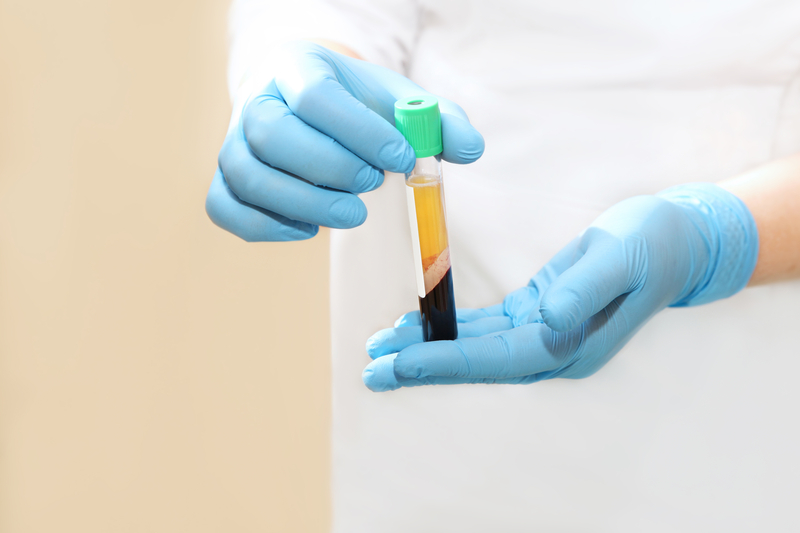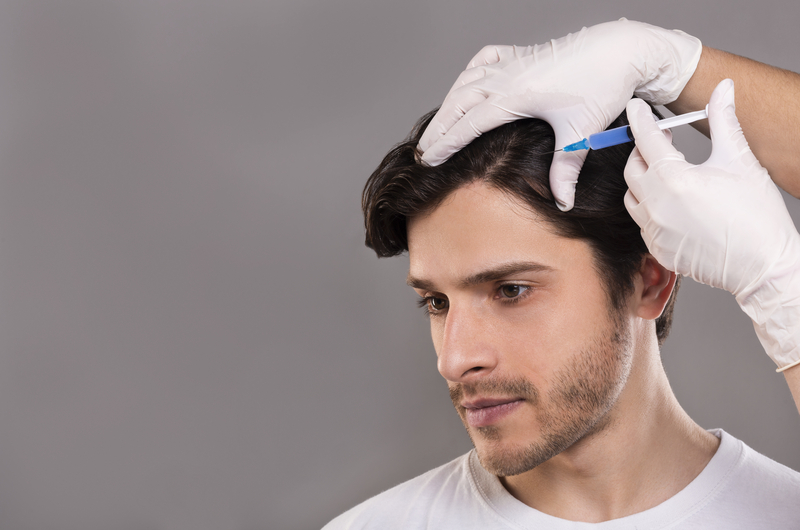Is Platelet-Rich Plasma For Hair Loss a Scam?
With many conventional hair loss treatments taking too long to produce results, having too many side effects, or being supported by shoddy science, people are looking for hair restoration alternatives.
One of the candidates reported to make waves in the hair loss industry is known as a platelet-rich plasma (P R P) injection.
Not only is it being promoted as a stand-alone treatment, but some scientists claim it “plays nice” with other hair loss treatments.
But does it actually work in the real world right now? And do the benefits outweigh the risks?
This article will give you all the information you need to make an informed and wise decision.
What Is Platelet-Rich Plasma Treatment For Hair Loss?
Don’t be intimidated by the name — the process is very simple to understand and takes just a few sentences to explain:
“Blood taken from the patient is placed in a special centrifuge and spun to separate the components: red blood cells, plasma, and platelet-rich plasma. The latter is then extracted and spun a second time to achieve an optimal concentration of growth factors (five to 10 times greater than in the bloodstream). Finally, it’s injected into the patient’s scalp wherever they are experiencing thinning.”
So what’s so special about one particular component of your blood in relation to thinning hair?
Time for a quick review of high school biology to understand what’s really going on:
“Platelets in your blood play a role in clotting and healing. They are the cells that contain the cell signaling agents that quarterback, or orchestrate, the human body’s tissue rejuvenation and healing systems. Plasma is the liquid in blood that carries the platelets, along with red blood cells and white blood cells.
During a procedure, the doctor separates platelets from your blood and processes them to concentrate the growth factors. Once injected into your scalp, increases blood flow to the hair follicles, stimulates the growth of new follicles, and lengthens the anagen (active) phase of the hair cycle to promote new hair growth.”
Some of the growth factors include TGF (transforming growth factor) and VEGF (vascular endothelial growth factor), both of which are known to increase blood flow in the human body.
So the primary idea involves the improvement of blood flow to a very specific part of your body (i.e. the hair follicles on your scalp) using an extremely concentrated amount of said growth factors.
The same factors which help heal injuries can supposedly restore hair follicle health… or can they?
The platelets themselves contain proteins such as VEGF (vascular endothelial growth factor) and TGF (transforming growth factor), all of which contribute to new follicular development and increased blood flow.
Why Platelet-Rich Plasma Treatment Works Poorly For Hair Loss
So what’s the deal with injections being used by hair loss practitioners to regrow hair on the scalp?
If it is claimed to show so much therapeutic promise in its early stages, where are the risks for the patient?
There are 5 key reasons why you may want to look for alternative treatments to injections for the time being… at least until all the downsides and side effects can be significantly mitigated.
Results Are Not Visibly Noticeable To The Human Eye
In all fairness, injections do have some promising results.
Such as this small human study involving 11 individuals who failed to see results after 6 months of using Minoxidil or Finasteride to treat genetic hair loss:
“A total volume of 2-3 cc was injected in the scalp by using an insulin syringe. The treatment was repeated every two weeks, for a total of four times. The outcome was assessed after 3 months by clinical examination, macroscopic photos, hair pull test and patient’s overall satisfaction.
A significant reduction in hair loss was observed between first and fourth injection. Hair count increased from average number of 71 hair follicular units to 93 hair follicular units. Therefore, average mean gain is 22.09 follicular units per cm2. After the fourth session, the pull test was negative in 9 patients.”
And while there are more human studies finding improvements in overall hair thickness and number of hair follicles, these studies don’t give you a visual picture of what this hair growth actually looks like.
Put in more understandable terms, any benefits derived aren’t visibly noticeable unless under a magnifier (small vellus hairs at best).
Any quick glance at before-and-after pictures makes you wonder if any results were achieved at all!
Combined with the fact that many clinics do injections in their own unique way, there remains a serious lack of a standardized protocol proven to work uniformly for different types of hair loss in men and women.
It could potentially work, but we’re going to need to see a lot more evidence.
Platelet-Rich Plasma Injections Are Extremely Painful And Uncomfortable
If you look up the side effects of injections for hair loss, you’ll notice the following list come up:
- Itching at the scalp
- Pain at the site of injection
- Swelling and tenderness in the scalp
- Temporary bleeding
- Possible headache
Seems as if the downsides are both mild and expected, and highly connected to what you would expect with any treatment involving a needle.
However, it is sad to see many physicians and aestheticians downplay how much pain is experienced.
Even for those people with an extremely high pain tolerance, the procedure can be excruciating.
One source we found which talked about injections more truthfully had the following to say about post-procedure steps to take:
“Keep the site clean and dry. Leave the bandage on for 12 to 24 hours and then replace the bandage with a Band-Aid until the site heals. You may shower but change the bandage if it gets wet.
DO NOT use ice on the site because ice reduces swelling. The therapy is meant to cause swelling, which helps you heal. You may have some swelling and bruising for three to seven days.
You may have severe pain at the site for 24 to 48 hours. Please use Tylenol or Ultram (tramadol) as needed, but do not take more than 3,000 mg of Tylenol in 24 hours.”
Granted, this is not on the level of what you would expect with a conventional hair transplant, but nevertheless it is important to fully disclose the severity of pain to patients in advance.
Not to mention that factors such as a low platelet count and being on blood thinners will automatically disqualify you from getting results!
Platelet-Rich Plasma For Hair Loss Is Very Expensive
If you go online and search for the cost of a total package involving numerous treatments, you will find a wide range of results.
But just to give you a ballpark estimate, Healthline provides a reasonable expectation for first-time users:
“ therapy typically consists of three treatments in a 4–6 week period, with maintenance treatments every 4–6 months.
The price typically ranges from $1,500–$3,500 for the initial three treatments, with one injection at $400 or more. Pricing depends on a number of factors including: your geographic location, quality of equipment, the addition of nutritive components”
And if you think you’re going to have this cosmetic procedure covered by your health insurance, you are sadly mistaken.
Board-certified physician and hair loss expert Dr. William Yates weighs in on why you’ll have to cover 100% of the cost out of pocket:
“Insurance never covers hair restoration, regardless of the cause… Insurance will usually pay to treat the conditions that cause hair loss — just not the hair loss itself. For example, if you have [polycystic ovarian syndrome], your insurance may cover exams and tests to treat the disease.
Depending on the diagnosis, treating the underlying cause may influence the hair to regrow. When it doesn’t, you will have to pay out of pocket. If you have androgenetic alopecia, you won’t get any insurance coverage at all for treatment”
Time to start saving up if you’re serious about this form of hair loss treatment!
Platelet-Rich Plasma For Hair Loss Requires Non-Stop Maintenance
Similar to hair loss drugs such as Finasteride and Minoxidil, injections are a lifelong commitment.
If you read the Healthline quote from the previous downside we just discussed, you’ll notice that you’ll need many more treatments after the initial 1-3 sessions.
Although they claim you need a new injection every 4-6 months, other hair loss clinics are more generous with their recommendations:
“The number of sessions can differ for each person. It depends on factors like the extent of hair loss and overall health. Multiple therapy sessions are required to achieve the desired hair regrowth.
“…Once the results appear, patients will need follow-up visits every 6 to 12 months to maintain and boost the effects of the treatment. Although the solution is not permanent, it can definitely offer long-lasting results.”
You’re spending an extra $1,000-1,500 for the rest of your life to maintain your hair.
That cost may be easily worth it for people with a higher net worth, but such a cost may be bank-breaking for the average person.
Keep reading until the end of this article for a permanent solution that doesn’t require an endless number of treatments…
Platelet-Rich Plasma Injections Only Work For Very Specific Treatments
In our experience as hair loss specialists, there are only two conditions where is most useful — and they have nothing to do with your hair.
The first is for a cosmetic procedure known as a “vampire facial”:
“The vampire facial (also known as a vampire facelift, a platelet-rich plasma facial, or facial) involves taking a sample of your own blood, extracting the plasma (the liquid part of your blood), and then injecting it with needles back in your face.
Why plasma? It’s rich in platelets, growth factors, and other nutrients that reportedly stimulate the growth of collagen and healthy skin cells”
This procedure instantly became famous back in 2013 when it was promoted by Kim Kardashian on her Instagram page.
(WARNING: If you are squeamish when it comes to blood, do not look up images of this procedure online)
Claimed benefits of this dermal procedure include reduced wrinkles, tighter skin, enhanced skin tone, and an overall more youthful appearance.
The second practical application of is orthopedic in nature, which usually involves the treatment of injuries:
“Platelet-rich plasma () therapy uses injections of a concentration of a patient’s own platelets to accelerate the healing of injured tendons, ligaments, muscles and joints. In this way, injections use each individual patient’s own healing system to improve musculoskeletal problems.
“…Platelet-rich plasma has been found to significantly enhance the healing process, and using a injection for shoulder pain caused by rotator cuff tears, for Achilles tendon ruptures and for other soft-tissue injuries is becoming more common.
has also been demonstrated to improve function and reduce pain in people who have tendonitis or chronic tendinosis conditions such as tennis elbow or golfer’s elbow.”
Given the mechanism through which injections are purported to work for hair loss, it stands to reason they have greater medical uses beyond making men and women look more like men and women.
The BEST Alternative To Platelet-Rich Plasma For A Fuller Head Of Hair
So what’s truly effective when it comes to addressing the age-old issue of hair loss?
Without question, the best method for hair follicle restoration is Vantis Follicle Replication (VFR).
VFR is our proprietary scalp micro-pigmentation solution for giving you the aesthetic appearance of a fuller head of hair.
It offers numerous advantages over injections and many other ineffective hair loss solutions:
- Visible results are both immediate post-treatment and long-lasting
- Hair regrowth/maintenance procedures can be used after 4-6 treatments
- No invasive surgery or down-time required
- No unwanted side effects
- Treatments are more affordable over the span of your lifetime
Best of all, no injections are required! 😉
We would love for you to take a look at our before-and-after pictures from enthusiastic customers and see the Vantis difference for yourself.
And when you’re ready to join hundreds of people who have experienced the life-changing benefits of VFR, there are 3 easy things you can do immediately…
- Visit our hair loss clinic in Newport Beach, California and receive a Free Consultation with a Vantis hair loss expert.
- Call or text (949) 577-6531 to talk to one of our VFR expert practitioners now
- Receive a virtual consultation via Zoom, Facetime, WhatsApp, GoogleMeet or Skype to answer all of your questions and develop a personalized treatment plan to achieve your desired results. Schedule your FREE consultation here


